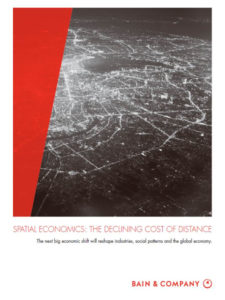 Spatial Economics: The Declining Cost of Distance
Spatial Economics: The Declining Cost of Distance
Bain & Company
First published February 2016
One trend being watched in the business / corporate world is that of the Declining Cost of Distance. In the past, the cost of distance has been the dominant driver of where businesses locate, where they produce, sell and do business, and where people decide to live, shop, play and work. The cost of distance is measured as the cost of moving things – information, goods, people. And for a long time that cost determined physical location of both work and workers.
According to a study entitled Spatial Economics: The Declining Cost of Distance, “For centuries, the cost of distance has determined where businesses produce and sell, where employers locate jobs and where families choose to live, work, shop and play. What if this cost fell dramatically, thanks to new technologies? How would the global economy change if manufacturers could produce locally in small batches, without incurring excess cost? Would existing business models and supply chains, for instance, suddenly become uncompetitive? If people could work from anywhere, would crowded neighborhoods start to thin out?
That change already has begun in the world’s advanced economies and is gathering momentum. Over the next two decades, the cost of distance will decline sharply, according to Bain research, altering the way we live and work—faster than most people expect and more broadly than many imagine.”
Download Resource
